This is the second part of a two-part article. Read the first part here.

In part one, we saw the dramatic effect of the Second Omoto Incident and its aftermath on the life and psychology of Morihei Ueshiba. Many of the ties he had developed over a period of 15 years became instantly severed or pushed into the background due to the persecution by the Japanese government of the Omoto religion. After a period in hiding in the house of the Sonezaki police chief, Morihei was able to resume his life and teaching activities.
Some things had changed. The interior of the Kobukan Dojo had all of the calligraphic works and symbols of the Omoto removed or destroyed and there were no more visits from the Omoto sect’s dignitaries who had frequently come in previous years. The Budo Senyokai network was dismantled although it appears that some groups kept training while maintaining a low profile. Morihei Ueshiba continued with his teaching assignments at the various military institutions and also with his regular visits to the Osaka area where several of his students were active teaching and where he had affiliated dojos.
There was one other dramatic change in Morihei’s life at this time that had nothing to do with the Second Omoto Incident. In June 1936, Sokaku Takeda appeared at the Asahi News in Osaka announcing himself as Morihei’s teacher and Sokaku ended up taking over instruction in Ueshiba’s place. A number of puzzling events surround this incident and I cover what is known in some detail in my article “Remembering Takuma Hisa.” Although the loss of such a prestigious teaching assignment must have been troubling, Morihei still had a strong presence in Osaka and continued to teach there regularly up until his retirement to Iwama. About this time another blow for Morihei was the departure of several of his top assistants. Shigemi Yonekawa relocated to Manchuria where he helped Kenji Tomiki. Rinjiro Shirata was conscripted into the military in 1937. Kaoru Funahashi disappears from the scene about this time although little is known about the remainder of his life. Zenzaburo Akazawa also departed to Manchuria as an assistant to General Toshinari Maeda. Also, Kiyoshi Nakakura and Morihei’s daughter ended their marriage the same year leaving the issue of Morihei’s successor in limbo. Yet perhaps the greatest difficulty was the fact that the Kobukan Dojo and other affiliated branch schools were losing increasingly more young men to the war effort leaving few students in the dojos.
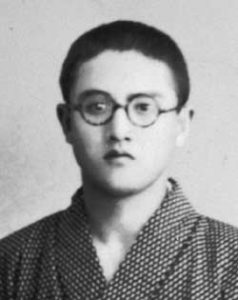
Among Morihei’s prominent students who remained on the scene was Gozo Shioda. Shioda was the son of a wealthy pediatrician who loved the martial arts. Still a student, the young Shioda was able to continue training at the Kobukan long after many of the other Kobukan instructors were called into military service. Shioda would go on to become a major figure in the postwar development of aikido as the founder of the Yoshinkan Aikido school. Also, Morihei’s son Kisshomaru began to practice regularly in the mid-1930s and would frequently assist his father in demonstrations as his sword partner. Kisshomaru also spent about a year studying Kashima Shinto-ryu sword when instructors from this classical school would make weekly visits to the Kobukan Dojo starting in 1937.
Morihei’s frail heath
A word about Morihei’s rather frail constitution is perhaps called for here. Kisshomaru mentions this in his 1977 biography of his father and attributes Morihei’s condition to the ill effects of a bizarre salt water drinking challenge in 1925 that Morihei participated in while living in the Omoto community. Apparently, someone calling himself a “Brahman Practitioner” kept challenging Onisaburo to a drinking contest and Morihei stepped in his place imbibing large quantities of salt water.
Of course, it is only speculation what combination of factors led to Morihei’s frequent illnesses, but his frail health condition is often alluded to in episodes recounted by Ueshiba’s prewar disciples. His nephew, Yoichiro Inoue, made mention of how often he would have to teach in Morihei’s place in the early Tokyo years due to his uncle’s illnesses. Gozo Shioda recounts how Morihei was very sick with jaundice in 1941 at the time of a demonstration before the imperial family.
Even without these first-hand testimonies it would be a simple matter to deduce that Morihei was frequently ill because of the constant and sometimes dramatic weight fluctuations apparent in surviving photos of the founder.
Remember that Morihei traveled constantly all around Tokyo and then to the Kansai area each month. His eating and sleeping habits were irregular and this surely had a negative effect on his health. In fact, careful scrutiny of photos from this period will reveal that Morihei aged rapidly between the years of around 1935 to 1940. Just before the Second Omoto Incident, we see him in his physical prime sporting an elegant Kaiser mustache. Photos of him dating from 1938 and beyond reveal that he has grown completely white and aged noticeably. No doubt it was a combination of all of the factors alluded to above that contributed to his poor health condition.
Some things had changed. The interior of the Kobukan Dojo had all of the calligraphic works and symbols of the Omoto removed or destroyed and there were no more visits from the Omoto sect’s dignitaries who had frequently come in previous years. The Budo Senyokai network was dismantled although it appears that some groups kept training while maintaining a low profile. Morihei Ueshiba continued with his teaching assignments at the various military institutions and also with his regular visits to the Osaka area where several of his students were active teaching and where he had affiliated dojos.
Morihei’s right-wing associations
Having earlier described the events of the Second Omoto Incident, this is an opportune moment to broach the subject of Morihei’s extensive right-wing associations and what significance should be attached to them. This topic has recently been alluded to by several Western writers. Until recently, aikido historians have mentioned Morihei’s many military and political associations mostly in an effort to demonstrate the high regard in which he was held by the elites of prewar Japan.
To be sure, this is a delicate matter because if it were adjudged that the aikido founder was active in the support of militarist causes then his portrayal of aikido as a “spiritual” martial art would be brought into question. On the other hand, the whole martial arts subculture of Japan has been bound up with the political and military happenings of the times going as far back to the beginnings of recorded history. So in one very profound sense, how could Morihei Ueshiba not have been involved deeply in right-wing activities given his profession and the types of people he associated with in his daily life? The whole matter is extremely complex so what I would like to attempt to do here is provide relevant background information on this subject.
Beginnings of right-wind contacts
The majority of Morihei’s right-wing associations can be traced back to his involvement in the Omoto religion starting about 1920. For example, his connection with Vice-Admiral Seikyo Asano, an Omoto beliver and one of Morihei’s early students in Ayabe, would serve as the basis for the creation of a vast network of contacts with high-ranking naval officers. Later, beginning in the mid-1920s when Morihei established himself in Tokyo, his connections would grow to include many leading army officers and police officials. In the numerous photos remaining from the late 1920s and 30s, it is common to see uniformed military officers interspersed among Morihei and his students.
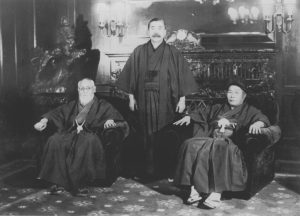
Of course, Morihei’s mentor, Onisaburo Deguchi, was also deeply involved in politics and cultivated many right-wing contacts. These included such famous figures as Mitsuru Toyama and Ryohei Uchida, both key figures in the notorious Black Dragon Society and other right-wing organizations. Toyama and Uchida’s activities very much involved Manchuria and Mongolia. Many of their efforts were designed to thwart Russian advances in this region thus furthering Japanese colonial interests on the continent. These famous figures were among the powerbrokers behind the aggressive activities of the Guandong Army (Kantogun) that would later lead to war against China and Russia.
Mongolian expedition
Given Onisaburo’s behind-the-scene activities and involvement with the likes of Toyama and Uchida, it is naive to hypothesize that his ill-fated expedition to Mongolia in 1924 had no political dimension beyond the stated goal of establishing a “religious utopia.” Someone as intelligent and politically astute as Onisaburo was certainly aware of the hidden agendas of the secret Japanese groups operating on the continent and may even have been working in concert with them. And let us not forget that Morihei Ueshiba was one of only several men handpicked to accompany Onisaburo on his secret trip to Mongolia. Morihei was certainly “in” on these political and military maneuverings from early on in his career.
Morihei’s network of right-wing contacts would later be amplified by the associations and activities of his students. To mention several examples, Yoichiro Inoue, Kenji Tomiki, Gozo Shioda, and Zenzaburo Akazawa all had extensive contacts that included military and political higher-ups, some of which surely overlapped with Morihei’s associations. This is simply a reflection of the times and the circles in which these martial arts figures moved.
Teaching at military institutions
From a westerner’s viewpoint, the most problematic aspect of Morihei’s prewar activities is his numerous teaching assignments at military institutions. In part one, we documented his involvement with the Naval Staff College, the Army University, the Military Police School, the Toyama School, and the Nakano “Spy” School among others. The question that comes to mind is, to what extent, if any, did the founder’s activities in these circles go beyond the instruction of martial skills and strategies? Surely, Morihei interacted with the staffs and students of these institutions and kept abreast of current events. But if Morihei was involved in some way in the unending political intrigue that constantly destabilized Japanese politics of the day, what evidence of this is there?
There is one curious episode that can be mentioned in this regard that may suggest some heretofore unknown role of Morihei in the political goings on of the times. Kisshomaru published an old undated photo in his Moriheiden in 1977 commemorating a visit to the Kobukan Dojo of a Chinese-looking foreign dignitary. The visitor is referred to merely as “Tokuo” and no information about the significance of this visit is given.
A little digging yielded the fact that Tokuo’s Chinese name was Prince Teh Wang (1902-1966) and that he sided with the Japanese authorities in Mongolia in the 1930s. Teh Wang forged a certain degree of political unity among Mongolian chieftains and declared an independent nation called Meng Chiang in December 1937. This government was backed up by the Japanese interests on the continent and the whole setup was reminiscent of Manchukuo headed by Pu-yi of Last Emperor fame. Teh Wang reigned in his largely symbolic capacity until 1945.
In any event, Prince Teh Wang visited Japan in 1938 and received an audience before Emperor Hirohito befitting his role as a foreign head of state. On this same visit, Teh Wang also paid a courtesy call at the Kobukan Dojo of Morihei Ueshiba. At least two photos of this event survive, one of which we reproduce here:
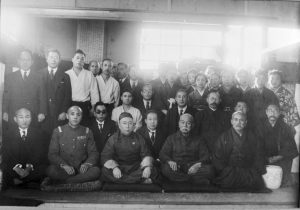
What significance should be attached to this visit is unclear. Besides the Mongolian emperor and Morihei, one army officer is present as is retired Admiral Isamu Takeshita. Others identified in the photo are Mrs. Ueshiba, Gozo Shioda, Kenzo Futaki and Aritoshi Murashige. It would be intriguing to learn more of the circumstances of this royal visit, but judging from the presence of several young men wearing keikoki, we can safely conclude that Morihei gave a demonstration for the emperor.
Indications of Morihei’s state of mind
While the circumstantial evidence of Morihei’s involvement in right-wing activities is nothing less than mountainous, we should pause for a moment to examine any indications of the founder’s state of mind at this stage of his life. Useful in this regard is an essay credited to him that appeared in Budo, a 1932 newsletter of the Budo Senyokai, that discusses the role of budo in modern society.
Consider first of all, these comments that place Morihei squarely in line with the prevailing rhetoric of the day in support of the “Imperial Way.”
… the true task of Japanese martial arts is to become the leader of all the martial arts on earth as part of the continuing process of realizing an Imperial Way for the whole world. Japan is the suzerain of the globe, the model for the earth and the will of the entire world is Greater Japan. Japan is the model form for the perfect world. It is only after this spirit is completely understood that one can really understand the true meaning of Japanese martial arts.
This kind of rhetoric is very typical of the day although it is a bit surprising to find it in the Omoto newsletter considering the frequent anti-governmental stances of the sect. Nevertheless, as we have seen, Onisaburo had his hand in many political pots that involved right-wing factions, so perhaps we should not be surprised that these words reflect the current policy of the sect as well. The text was actually written by an Omoto higher-up named Bansho Ashihara based on notes from lectures and conversations with Morihei. It may be that a certain amount of license was used and various embellishments added. Similar sentiments appear in other articles bearing Morihei’s name in different issues of the newsletter.
The evidence would suggest that Morihei was, for the most part, supportive of Japan’s imperialist policies in a secular sense. However, at the same time, his embrace of the tenets of the Omoto religion and natural spiritual inclinations caused him to view budo as a path to self-realization in the service of the heavenly kami.
In fact, we find passages from another essay by Morihei published elsewhere in the newsletter that capture the essence of budo in a more spiritual sense using terms that anticipate the founder’s postwar language:
After you have reached a certain level in training of the “Way of the Sword,” you can feel your enemy’s intention to strike before the blade begins to cut downward. I, myself, have had the experience of sensing a one-inch, white-colored ‘idea-bullet’ and heard its whizzing sound as it flew toward me before the actual bullet was fired. In true budo, however, simply foreseeing the enemy’s plan is not sufficient. Equipping your inner self with the power to move the enemy according to your own will is the true Way of the Kami…
To summarize, my present thinking on this issue is that Morihei’s support of the Japanese military establishment had a certain ambivalence about it. Of course, his high social status and livelihood depending on him playing an active role in support of military and political causes at least in an outward sense. Counterbalancing this was Morihei’s deep interest in spiritual matters and ascetic training. Although all sorts of political maneuverings were going on around him, I have never seen a document or heard an episode that speaks of the founder playing any kind of active role in a political cause.
One hypothesis was that Morihei became increasingly upset at the excesses of the military and could foresee the defeat of Japan well before this became apparent to the average observer. Remember too that among Onisaburo’s predictions in the Reikai Monogatari were accounts of “bird-ships of the heavens” that would reign destruction on Japan. Perhaps, the strongest bit of evidence for Morihei’s growing dissatisfaction with the war effort was the timing of his total retreat to Iwama at the height of war in 1942. Surely this is a subject that will have to be revisited over and over again as more information suggestive of Morihei’s frame of mind comes to light.
Establishing a teaching presence in Manchuria
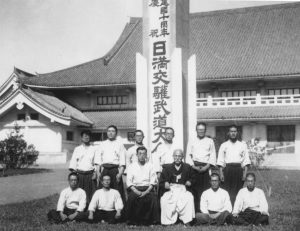
The Japanese had in the 1920s and 30s developed a massive presence in Manchuria and gained complete political control by 1932 when the Manchukuo nation was established. We saw that Yoichiro Inoue made a visit to Manchuria in 1933 and then Kenji Tomiki relocated to Shinkyo (present-day Changchung) in 1936 where he first taught at the Daido Gakuin, and members of the Kanto Army and the Imperial Household Agency. With the opening of Kenkoku University in 1938, Tomiki joined the teaching staff and offered courses in judo and aiki budo.
The evidence would suggest that Morihei was, for the most part, supportive of Japan’s imperialist policies in a secular sense. However, at the same time, his embrace of the tenets of the Omoto religion and natural spiritual inclinations caused him to view budo as a path to self-realization in the service of the heavenly kami.
Tomiki invited Morihei to instruct at the university in 1939. During this stay, Morihei met the famous sumo wrestler Tenryu—by then retired—who attempted to test the old man’s strength. Tenryu was highly impressed with Morihei’s mastery and received permission to take a leave to return to Tokyo to study for three months at the Kobukan Dojo. The meeting with Tenryu was yet another episode where Morihei displayed his uncanny martial skills. In this case, his partner was a famous figure in the sumo world known for his physical strength. This was the beginning of a life-long friendship between the founder and Tenryu and the latter was very supportive of the Aikikai and the Yoshinkai organization of Gozo Shioda after World War II.

It appears that Morihei made yearly trips to Manchuria during the summer from 1939-1942. He became a martial arts adviser to Kenkoku University and gave seminars and demonstrations assisted by Tomiki. Morihei was widely recognized as one of the top martial arts instructors among the Japanese delegations that visited the continent. This is confirmed by his central seating position in several of the group photos taken in Manchuria during this period. His last trip was in 1942 when he again participated in a large demonstration and is also said to have made a side trip to Beijing that may have had some political ramifications according to Kisshomaru in his biography of Morihei.
As a side note, we point out that one of Kenji Tomiki’s students at Kenkoku University was a young man named Shigenobu Okumura. He trained under Tomiki and Hideo Oba for several years at the university and also visited the Kobukan Dojo during vacations. Okumura was a key person within the Aikikai organization after the war and continues active today as a 9th dan shihan.
Creating the Zaidan Hojin Kobukai
In 1939, several of Morihei’s key supporters began taking steps to create a non-profit corporate structure for the Kobukan Dojo. This resulted in the official approval of the Zaidan Hojin Kobukai on April 30, 1940. Kisshomaru credits Yoji Tomosue of the Ministry of Health and Welfare who paved the way for official approval of the application, and a businessman named Shozo Miyazaka who made a 20,000 Yen contribution toward the new foundation. The first chairman was retired Admiral Isamu Takeshita with General Katsura Hayashi as vice chairman. Among the board members were Count Fumimaro Konoe, Count Toshitame Maeda, Takuo Godo, Kinya Fujita, Kozaburo Okada, Kenji Tomita, and Kenzo Futaki and other well-known people.
The existence of the Kobukai Foundation gave the dojo a legal identity and facilitated the handling of finances and management tasks. This organization was disbanded at the end of the war by the GHQ but was revived as the Zaidan Hojin Aikikai which received official approval in 1948.
New blood at the Kobukan
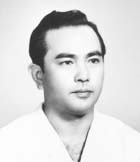
There were several bright prospects among the new students who entered the Kobukan Dojo starting around 1940. The most well-known of these is Koichi Tohei who played a major role in the postwar development of aikido at the Aikikai before forming his own independent school in 1974. Tohei was a student at Keio University when he joined the Kobukan Dojo and made quick progress. He trained for a total of a year and a half even assisting the founder on outside teaching assignments before being inducted into army in 1942 and sent into battle.
Another important figure who would achieve postwar prominence was Kisaburo Osawa who joined a few months after Tohei in 1941. Osawa was about 30 years old at the time he enrolled and often assisted Minoru Hirai, the latter being General Affairs director at the Kobukan. Many years later Osawa served as dojo-cho of the Aikikai Hombu Dojo and as a special assistant to the Second Doshu Kisshomaru Ueshiba.
We made brief mention of Minoru Hirai (1903-1998) above. Hirai joined the dojo about 1939 and assumed the post of General Affairs director in January 1942. He served primarily in an administrative capacity and played a key role in the selection of the name “aikido” as we shall see below. Hirai established his own dojo after the war and called his system Korindo.
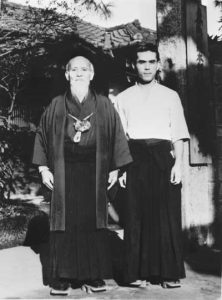
One other young man deserving of mention joined the dojo in 1942. This was Kanshu Sunadomari who came from a devout family of Omoto believers. Morihei had a connection with Sunadomari’s older brother, Kanemoto, dating back to the Ayabe days in the 1920s. The older Kanemoto is credited with writing the first biography of Morihei Ueshiba which was published in February 1969, a mere two months before Morihei’s death. Kanshu began training in 1942 and was conscripted into the army in 1943. Like Tohei, the younger Sunadomari was called to assist Morihei in instructing on outside assignments such as at the Nakano Spy School despite his young age and inexperience. Kanshu established the now independent Manseikan Dojo in Kumamoto, Kyushu in 1954 and has been active continuously since that time.
Dai Nippon Butokukai and the naming of aikido
A great deal of misunderstanding exists concerning the subject of how aikido actually got its name. Most people think reflexively that Morihei decided on the name “aikido” himself and that the term encapsulates his spiritual vision of budo as a means for self-development and the attainment of world peace. At the risk of appearing iconoclastic, we must point out that the coining of the word “aikido” actually came about as the result of a bureaucratic decision taken in 1942 within the Dai Nippon Butokukai, an umbrella organization assigned the task of regulating the martial arts. The name was simply a contraction or simplification of the term “aiki budo” then in use to describe Morihei’s art. As the Butokukai came under government control, there was a push to standardize nomenclature to match with names such as judo, kendo, karatedo, etc. “Aiki budo” did not fit neatly into this pattern and the short form “aikido” was suggested and accepted as a generic term to group together the historical jujutsu ryuha.

The person who represented the Kobukan Dojo at this point in time was Minoru Hirai. He provides a description of the process in these words:
It was very difficult to create a new section in the Butokukai at that time. Mr. Hisatomi proposed the establishment of a new section including arts for actual fighting based on jujutsu techniques. The techniques of yawara (an alternate term for jujutsu) are comprehensive and also include the use of the ken and jo…
There was discussion within the Butokukai about the choice of a name for this new section. It was discussed many times in meetings of the Board of Directors, and particularly in the judo and kendo sections. We had to consider all of the different individual arts encompassed when we tried to come up with an all-inclusive name. It was decided to select an inoffensive name to avoid future friction among the different martial arts.
Mr. Hisatomi argued for his proposal energetically and explained that “aikido” would be a better name than “aiki budo” for this new section, because it would be better to stress the idea of “michi” or way. He proposed that the name “aikido” be used as term to designate an all-inclusive budo and I agreed with him. In other words, the term “aikido” was a cover-all term that could include other things as well…
The key term “aiki” within this context, of course, originates from “Daito-ryu aikijujutsu,” coined in 1922 in Ayabe when Sokaku Takeda spent six months in Morihei’s home teaching Omoto believers. The various explanations of the meaning of “aikido” that stress the blending or matching of ki with that of the opponent and carry with them philosophical overtones were postwar innovations.
Morihei’s prewar technical evolution
Let us now take a closer look at the techniques of the Kobukan Dojo era. Starting in the late 1920s through the mid-1930s Morihei was periodically in contact with Sokaku Takeda. Sokaku appeared in Tokyo on a number of occasions and gave seminars and received payments from Morihei. The founder’s early students such as Tomiki, Takeshita, Kamada, and others referred to the art they learned from Morihei as “Daito-ryu.” Morihei was still very much a part of the Daito-ryu world at this stage.
We saw in part one how the opening of the Kobukan Dojo in 1931 was immediately preceded by a visit from Sokaku. Now that he had his own dojo, a solid teaching schedule, and the firm backing of the Omoto and Onisaburo Deguchi, Morihei began evolving further and further away from the traditional Daito-ryu methods. Somewhere in the early 1930s the term “aiki budo” also came into use and this change of names was surely a harbinger of his shift away from Daito-ryu. Fortunately, a wealth of materials has survived from this era allowing us to trace Morihei’s technical development through time.
Budo Renshu
A rather unusual training manual was published by the Kobukan Dojo in 1933 with authorship attributed to Morihei. This manual consists of some 166 techniques presented in the form of line drawings. Each technique includes an average of two to three illustrations. The illustrations were drawn by Takako Kunigoshi, an enthusiastic trainee at the Kobukan and an art school student at that time. Kunigoshi loved sketching and when dojo members saw her talents, she was encouraged to systematically draw the key positions of each technique as a means of prese0rving Morihei’s art. This manual was distributed to certain advanced students and supporters of Morihei and apparently was used to supplement the modified hiden mokuroku scrolls that Morihei was giving out in these years as a form of ranking.
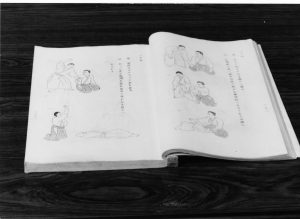
The techniques covered in Budo Renshu correspond in part to the Daito-ryu aikijujutsu techniques of the hiden mokuroku, the first level of the Daito-ryu curriculum. Although “Moritaka Ueshiba” is listed as the author of the manual, Kenji Tomiki stated in a 1978 interview with Aiki News that he actually edited the text of the book. This assertion is supported by the survival of a name card from the early 1930s listing Tomiki as the “Jonin Kanji” (lit., “Permanent Secretary”) of the Kobukan Dojo. In any event, it is clear that the actual text was not written by the founder.
A bilingual version of Budo Renshu based on a translation by Larry and Seiko Bieri was published in 1978. This included reproductions of Kunigoshi’s line drawings and the original Japanese text. It has since been reprinted in a paperback edition.
A great deal of misunderstanding exists concerning the subject of how aikido actually got its name. Most people think reflexively that Morihei decided on the name “aikido” himself and that the term encapsulates his spiritual vision of budo as a means for self-development and the attainment of world peace. At the risk of appearing iconoclastic, we must point out that the coining of the word “aikido” actually came about as the result of a bureaucratic decision taken in 1942 within the Dai Nippon Butokukai, an umbrella organization assigned the task of regulating the martial arts. The name was simply a contraction or simplification of the term “aiki budo” then in use to describe Morihei’s art. As the Butokukai came under government control, there was a push to standardize nomenclature to match with names such as judo, kendo, karatedo, etc. “Aiki budo” did not fit neatly into this pattern and the short form “aikido” was suggested and accepted as a generic term to group together the historical jujutsu ryuha.
Noma Dojo photos
In 1936, a singular development took place that provides a clear snapshot of Morihei’s techniques at this stage of his career. A famous kendoka named Hisashi Noma—a close friend of Morihei’s adopted son Kiyoshi Nakakura— used his Leica camera to take more than 1,000 photos of Morihei demonstrating techniques. Hisashi, the son of famed Kodansha founder Seiji Noma, had won the kendo trophy in the Imperial Martial Arts Tournament (Tenranjiai) the previous year and had recently become a student of Ueshiba.

The photos depict Morihei performing hundreds of aikijujutsu techniques running the gamut from basic to advanced. Morihei’s uke in these photos is Shigemi Yonekawa, one of his favorite uchideshi. The Noma photos are full of complex joint-locks and pins and retain many of the characteristics of Daito-ryu aikijujutsu techniques.
Those who have described Morihei’s study of Daito-ryu aikijujutsu as brief and superficial are left with the task of explaining how he could have such a profound knowledge of Daito-ryu techniques. The control, positioning, perfect balance, attention to detail, and many other subtleties revealed in the Noma Dojo photos reflect a deep mastery of Daito-ryu.
Asahi News film
Of all of the surviving documents of the prewar era, perhaps the most important is the 1935 film of Morihei shot at the Asahi News company in Osaka. This film was shot in sound in 16mm format and runs approximately 14 minutes. Morihei demonstrates many suwariwaza, hanza handachi (hanmi handachi), tachiwaza, multiple attacks, and sword and juken techniques. His partners are Shigemi Yonekawa and Tsutomu Yukawa. There are brief appearances by Takuma Hisa and Rinjiro Shirata.
Most of the techniques preserved in this film are advanced and are performed in a flowing style building to a final crescendo with a spectacular multiple attack. One is struck by the modernity of many of the techniques and the “ki no nagare” like style of execution. The visual and sound impact of this film is tremendous and it provides a window in time to the wonderful techniques of Morihei of that period. The influence of Daito-ryu techniques in this film is much less obvious compared to the techniques contained in Budo Renshu and the Noma Dojo photos, the latter series being taken very close in time to the Asahi film.
Experimentation with weapons
In 1937, Morihei arranged to have instructors come from the Kashima Shinto-ryu school to teach at the Kobukan Dojo. He even went as far as enrolling in the Kashima school and his name appears in the register of the ryuha along with his blood oath (keppan). It seems that by the mid-1930s Morihei was experimenting a great deal with the sword and that he regarded the study of this weapon as central to the mastery of taijutsu.

Although it is not well-known, it should be noted that Morihei had received a diploma (menkyo) in Yagyu Shinkage-ryu from Sokaku Takeda in Ayabe in 1922. What sort of training he received in the sword in this connection is unknown. Later, beginning in the late 1920s, Morihei had exposure to such people as Kosaburo Gejo, an exponent of Yagyu Shinkage-ryu and friend of Admiral Takeshita, who was a frequent visitor at Ueshiba’s training sessions. Morihei also had a long-standing friendship with Hakudo Nakayama of kendo fame and thus was exposed to a high-level of sword work through this association.
Later after Kiyoshi Nakakura was adopted into the Ueshiba family, Morihei authorized the setting up of a kendo club within the Kobukan Dojo. A few of the uchideshi such as Shirata, Hashimoto, and Funahashi also took kendo lessons from Nakakura and therefore sword training was a regular occurrence at the dojo.
In the 1935 Asahi News film there is a segment containing a rather spontaneous, kata-like sword demonstration that suggests that he was at that time in the process of experimentation. Also, in the 1938 technical manual titled Budo there are a number of paired sword techniques and sword take-away techniques shown. In this sense, solid groundwork for Morihei’s intensive study of the aiki ken and jo in Iwama during and after the war was laid during the Kobukan period.
Budo
Another important technical legacy from the prewar era is the training manual titled simply Budo published in 1938, again under the name of “Morihei Ueshiba.” This book was compiled for Prince Kaya who had recently become a student of Morihei. Kayanomiya, as he was known, was an army officer and later became Superintendant of the Army Toyama School from 1942-43.
Budo contains 50 pages and is divided into two parts: an essay on “The Essence of Techniques,” and a second part presenting 50 techniques demonstrated by Morihei through photographs. The material covered includes preparatory exercises, basic techniques, knife and sword-taking techniques, sword vs. sword forms, mock-bayonet techniques, and finishing exercises. Budo is the only written work in which the founder personally appears demonstrating techniques.
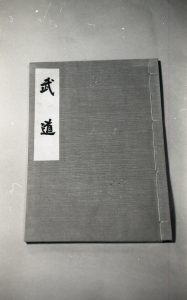
From a technical standpoint, Budo offers numerous insights into the prewar techniques of Morihei. First, it provides a capsule view of the techniques Morihei considered basics and the way they were executed in the mid-1930s. The techniques shown represent a transition phase between the Daito-ryu aikijujutsu Ueshiba learned from Sokaku Takeda and modern aikido. Several of the basic techniques bear strong similarity to those Morihei taught in Iwama after World War II and which are still practiced today in the Ibaragi Dojo of Morihiro Saito. Some who have seen the Budo manual are surprised at the large number of techniques performed with weapons. Fully one-third of the manual features techniques executed using the knife, sword, spear and mock-bayonet. As we have seen, Morihei had long been fascinated with weapons practice—particularly the ken and jo—and the use of these weapons formed a significant part of his personal training.
An English edition of Budo translated by John Stevens was published by Kodansha in 1991. Inexplicably, no Japanese version has appeared and thus Japanese aikidoka are still for the most part unaware of the existence of this important historical document.
Although it is not well-known, it should be noted that Morihei had received a diploma (menkyo) in Yagyu Shinkage-ryu from Sokaku Takeda in Ayabe in 1922. What sort of training he received in the sword in this connection is unknown. Later, beginning in the late 1920s, Morihei had exposure to such people as Kosaburo Gejo, an exponent of Yagyu Shinkage-ryu and friend of Admiral Takeshita, who was a frequent visitor at Ueshiba’s training sessions. Morihei also had a long-standing friendship with Hakudo Nakayama of kendo fame and thus was exposed to a high-level of sword work through this association.
Morihei’s prewar grading system
Morihei addressed the matter of ranking in different ways throughout his long teaching career. Early on, he patterned his gradings on the Daito-ryu aikijujutsu model. He gradually moved away from this practice before finally adopting the modern dan ranking system about 1940.
The earliest surviving sample of certification given by Morihei are the two makimono awarded to Minoru Mochizuki. Both are dated June 1932. The title of the first is “Daito-ryu Aiki Bujutsu” and its content is identical to the “Daito-ryu Aiki Jujutsu Hiden Mokuroku” given out by Sokaku Takeda as the first level of proficiency in Daito-ryu. The second is titled “Hiden Ogi,” the makimono awarded for the next highest level in the Daito-ryu tradition. Both makimono bear the signature of “Moritaka Ueshiba, student of Sokaku Takeda” and a seal that reads “Aikijujutsu.”

As Mochizuki, an extremely talented martial artist, had only trained with Morihei for a few months starting late in 1930, these awards were undoubtedly an expression of the esteem in which the founder held the young man and a gesture of support at the outset of Mochizuki’s teaching career as an operator of an independent dojo in Shizuoka.
Morihei probably began giving out such Daito-ryu-like makimono beginning in the late 1920s after he had established himself in Tokyo. Starting with people such as Admiral Isamu Takeshita, Kenji Tomiki, then later his top students and supporters, Morihei gave out an unknown number of “hiden mokuroku” patterned awards probably as late as the mid-1930s. He gradually changed the references at the end of these scrolls eliminating mention of “Daito-ryu aikijujutsu” and using such such formulae as “Aioi-ryu Aikijujutsu” to refer to his art. It is difficult to write in specific terms about this process since, to my knowledge, none of these makimono are publicly viewable. The author has only seen one of these Daito-ryu look-alike diplomas and a fragment of a second. Quite a number of Morihei’s prewar students have mentioned these award so their prevalence is not in question.
Some of his prewar students such as Akazawa, Kunigoshi, Bansen Tanaka, and others recall Morihei presenting his 1933 Budo Renshu and 1938 Budo books as surrogate rankings as well. The first contained technical illustrations in the form of line drawings while the latter incorporated photographs. Perhaps, in the view of some, these privately published books may be considered the modern equivalent of the old classical transmission scrolls.
In 1940, Morihei began giving out dan certificates through the newly-created Zaidan Hojin Kobukai. Photos of at least two of these prewar documents survive, one Kenji Tomiki’s 8th dan, and a 6th dan certificate for Shigemi Yonekawa that we reproduce below.
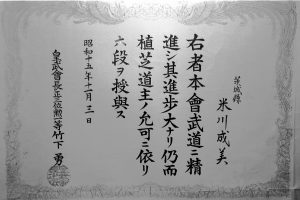
Due to the steady exodus of able-bodied men into military service that left few students at the Kobukan Dojo, it is doubtful that very many of these prewar dan certificates were given out.
End of the Kobukan Dojo era: Retirement to Iwama
The Kobukan Dojo era actually comes to an end with the withdrawal of Morihei to Iwama, Ibaragi Prefecture late in 1942. This was a particularly difficult time, not only for the founder, but for all of Japan as the major cities were undergoing frequent air attacks that made carrying out any semblance of a normal life an impossible task.
Morihei had been preparing Iwama as an outdoor retreat for some time and would spend time there as often as his schedule permitted. His health had again taken a turn for the worse, related to the accumulation of stress from the pressures of his personal life and the war conditions. Whatever the combination of factors may have been that produced his poor physical and psychological condition, his precarious health forced him to retreat to Iwama at the end of 1942. He appointed his son Kisshomaru, still a student at Waseda University, to take over the administration of the Kobukan Dojo assisted by Minoru Hirai.
Morihei left Iwama infrequently for the next 13 or so years and was able to concentrate his energies on healing his body, farming, meditation, and training. He had ample time to himself for the first time in many years to explore his art and spiritual being. Although Morihei’s move to Iwama signaled the end of the Kobukan Dojo era, it opened the way for the development of the modern form of aikido that has spread the world over as Japan’s spiritual martial art.
This is the second part of a two-part article. Read the first part here.

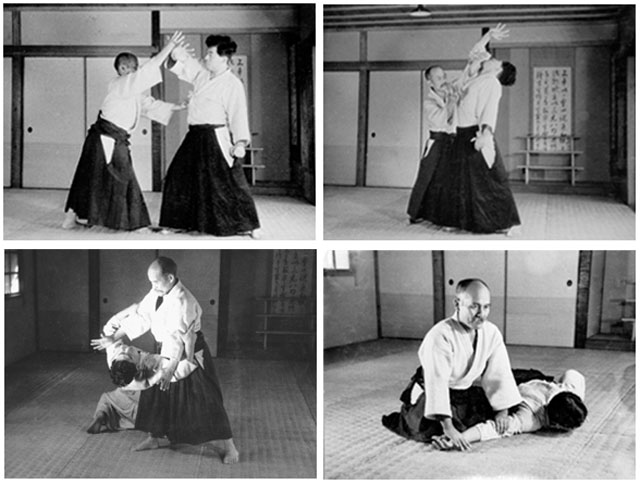


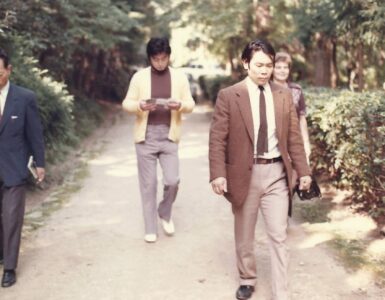
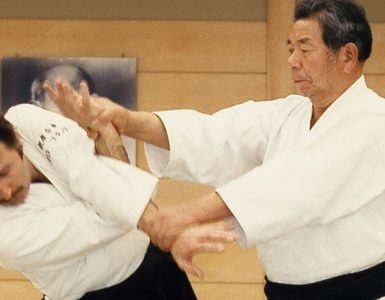







One of your best essays ever, but what struck me reading Budo, the manual does indeed show a large amount of weapons work, but there is no appearance of the Jo. When did the Jo become an Aikido weapon, and what influences were there in your opinion?
It seems that O-Sensei focused on the jo later starting in the Iwama years. But you see the seeds of this training in the yari (spear) and jukenjutsu (mock-bayonet) techniques. Details are very few and this remains a relatively unknown area.